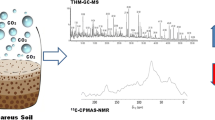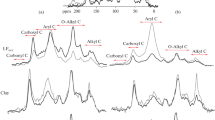Abstract
The shallow soils of Pianosa—a small calcareous island in the Mediterranean Sea, facing Tuscany, central Italy—developed under the same pedogenic factors with the exception of vegetation and, in the last two centuries, human impact. Originally, they were covered by “macchia,” a tangled mix of bushy species, or, in a few more fertile sites, by Quercus ilex L. Currently there are six land uses on the island: (1) pristine macchia, (2) groves of Olea europaea L. totally reinvaded by macchia, (3) degraded residual thickets of Q. ilex, (4) cropland, (5) recently abandoned pastures, and (6) stands of Pinus halepensis Mill. The related soils were analysed by solid-state cross polarisation/magic angle spinning 13C-nuclear magnetic resonance (NMR) to compare the spectroscopic properties of their organic pool. The prevalence of O-alkyl C over other C forms is evident in all cases, while there is large variability with respect to the alkyl C to aromatic C ratio between both the different soils, and the horizons of a same soil. On the whole, the results show that on Pianosa Island, human impact has profoundly altered not only the amount but also the quality of soil organic matter (SOM). The SOM residual of the dichromate oxidation in the Walkley–Black method—a widely used method to measure soil organic C—was also analysed by NMR. It comprised almost exclusively alkyl C and aromatic C, as a result of the removal of carbonyl and O-alkyl C. Most of the aromatic C seems to belong to charcoal.







Similar content being viewed by others
References
Almendros G, Tinoco P, Gonzalez-Vila FJ, Ludemann HD, Sanz J, Velasco F (2001) C-13-NMR of forest soil lipids. Soil Sci 166:186–196
Baldini RM (2000) Flora vascolare dell’Isola di Pianosa nel Mar Tirreno (Arcipelago Toscano): revisione tassonomica ed aggiornamento. Webbia 55:107–189
Baldock JA, Preston CM (1995) Chemistry of carbon decomposition processes in forest as revealed by solid state carbon-13 nuclear magnetic resonance. In: Mcfee WW, Kelly JM (eds) Carbon forms and functions in forest foils. SSSA, Madison, pp 89–117
Cano AF, Mermut AR, Ortiz R, Benke MB, Chatson B (2002) C-13 CP/MAS–NMR spectra of organic matter as influenced by vegetation, climate, and soil characteristics in soils from Murcia, Spain. Can J Soil Sci 82:403–411
Caravaca F, Masciandaro G, Ceccanti B (2002) Land use in relation to soil chemical and biochemical properties in a semiarid Mediterranean environment. Soil Tillage Res 68:23–30
Cook RL, Langford CH, Yamdagni R, Preston CM (1996) A modified cross-polarization magic angle spinning 13C NMR procedure for the study of humic materials. Anal Chem 68:3979–3986
Dignac M-F, Bahri H, Rumpel C, Rasse DP, Bardoux G, Balesdent J, Girardin C, Chenu C, Mariotti A (2004) Carbon 13-C abundance as a tool to study the dynamics of lignin monomers in soil: an appraisal at the Closeaux experimental field (France). Geoderma 128:3–17
Dunjo G, Pardini G, Gispert M (2003) Land use change effects on abandoned terraced soils in a Mediterranean catchment, NE Spain. Catena 52:23–37
Eusterhues K, Rumpel C, Kögel-Knabner I (2005) Stabilization of soil organic matter isolated via oxidative degradation. Org Geochem 36:1567–1575
Forte C, Piazzi A, Pizzanelli S, Certini G (2006) CP MAS 13C spectral editing and relative quantitation of a bulk soil sample. Solid State Nucl Magn Reson 30:81–88
Golchin A, Clarke P, Oades JM, Skjemstad JO (1995) The effects of cultivation on the composition of organic matter and structural stability of soils. Aust J Soil Res 33:975–993
IUSS Working Group WRB (2006) World reference base for soil resources, 2nd edn. World Soil Resources Reports No. 103, FAO, Rome, Italy
Keeler C, Maciel GE (2000) 13C NMR spectral editing of humic material. J Mol Struct 550–551:297–305
Keeler C, Maciel GE (2003) Quantitation in the solid-state 13C NMR analysis of soil and organic soil fractions. Anal Chem 75:2421–2432
Kiem R, Kögel-Knabner I (2003) Contribution of lignin and polysaccharides to the refractory carbon pool in C-depleted arable soils. Soil Biol Biochem 35:101–118
Kiem R, Knicker H, Körschens M, Kögel-Knabner I (2000) Refractory organic carbon in C-depleted arable soils, as studied by 13C NMR spectroscopy and carbohydrate analysis. Org Geochem 31:655–668
Kögel-Knabner I (1997) C-13 and N-15 NMR spectroscopy as a tool in soil organic matter studies. Geoderma 80:243–270
Kögel-Knabner I (2002) The macromolecular organic composition of plant and microbial residues as inputs to soil organic matter. Soil Biol Biochem 34:139–162
Mao J-D, Schmidt-Rohr K (2004) Accurate quantification of aromaticity and nonprotonated aromatic carbon fraction in natural organic matter by 13C solid-state nuclear magnetic resonance. Environ Sci Technol 38:2680–2684
Mao J-D, Hu W-G, Schmidt-Rohr K, Davies G, Ghabbour EA, Xing B (2000) Quantitative characterization of humic substances by solid-state carbon-13 nuclear magnetic resonance. Soil Sci Soc Am J 64:873–884
Mikutta R, Kleber M, Torn MS, Jahn R (2006) Stabilization of soil organic matter: association with minerals or chemical recalcitrance? Biogeochemistry 77:25–56
Miltner A, Zech W, Çepel N, Eler Ü (1996) Soil organic matter composition in three humus profiles of the western Taurus, Turkey, as revealed by wet chemistry and CP/MAS 13C NMR spectroscopy. J Soil Sci Plant Nutr 159:257–262
Nelson DW, Sommers LE (1996) Total carbon, organic carbon, and organic matter. In: Sparks DL (ed) Methods of soil analysis. Part 3: chemical methods. Book Series no. 5, Soil Science Society of America and American Society of Agronomy, Madison, pp 961–1010
Preston CM, Schnitzer M, Ripmeester JA (1989) A spectroscopic and chemical investigation on the de-ashing of a humin. Soil Sci Soc Am J 53:1442–1447
Quideau SA, Anderson MA, Graham RC, Chadwick OA, Trumbore SE (2000) Soil organic matter processes: characterization by C-13 NMR and C-14 measurements. For Ecol Manag 138:19–27
Rovira P, Vallejo VR (2002) Labile and recalcitrant pools of carbon and nitrogen in organic matter decomposing at different depths in soil: an acid hydrolysis approach. Geoderma 107:109–141
Sanchez-Maranon M, Soriano M, Delgado G, Delgado R (2002) Soil quality in Mediterranean mountain environments: effects of land use change. Soil Sci Soc Am J 66:948–958
Santi CA, Certini G, D’Acqui LP (2006) Direct determination of organic carbon by dry combustion in soils with carbonates. Commun Soil Sci Plant Anal 37:155–162
Schoeneberger PJ, Wysocki DA, Benham EC, Broderson WD (eds) (2002) Field book for describing and sampling soils. Version 2.0. Natural Resources Conservation Service, National Soil Survey Center, Lincoln, NE
Skjemstad JO, Taylor JA (1999) Does the Walkley–Black method determine soil charcoal? Commun Soil Sci Plant Anal 30:2299–2310
Skjemstad JO, Clarke P, Taylor JA, Oades JM, McClure SG (1996) The chemistry and nature of protected carbon in soil. Aust J Soil Res 34:251–276
Skjemstad JO, Taylor JA, Smernik RJ (1999) Estimation of charcoal (char) in soils. Commun Soil Sci Plant Anal 30:2283–2298
Smernik RJ, Oades JM (2003) Spin accounting and RESTORE—two new methods to improve quantitation in solid-state 13C NMR analysis of soil organic matter. Eur J Soil Sci 54:103–116
Smernik RJ, Skjemstad JO, Oades JM (2000) Virtual fractionation of charcoal from soil organic matter using solid state C-13 NMR spectral editing. Aust J Soil Res 38:665–683
Tarchitzky J, Hatcher PG, Chen Y (2000) Properties and distribution of humic substances and inorganic structure-stabilizing components in particle-size fractions of cultivated Mediterranean soils. Soil Sci 165:328–342
Walkley A, Black IA (1934) An examination of the Degtjareff method for determining soil organic matter and a proposed modification of the chromic acid titration method. Soil Sci 37:29–38
Zech W, Haumaier L, Kögel-Knabner I (1989) Changes in aromaticity and carbon distribution of soil organic matter due to pedogenesis. Sci Total Environ 81/82:179–186
Acknowledgements
We are indebted to Jan Skjemstad for critically reviewing the manuscript. This work is a contribution of the Pianosa LAB project.
Author information
Authors and Affiliations
Corresponding author
Rights and permissions
About this article
Cite this article
Certini, G., Forte, C., D’acqui, L.P. et al. Spectroscopic properties of bulk and dichromate oxidation resistant soil organic matter from an anthroposequence in a Mediterranean environment. Plant Soil 291, 55–65 (2007). https://doi.org/10.1007/s11104-006-9173-5
Received:
Accepted:
Published:
Issue Date:
DOI: https://doi.org/10.1007/s11104-006-9173-5




